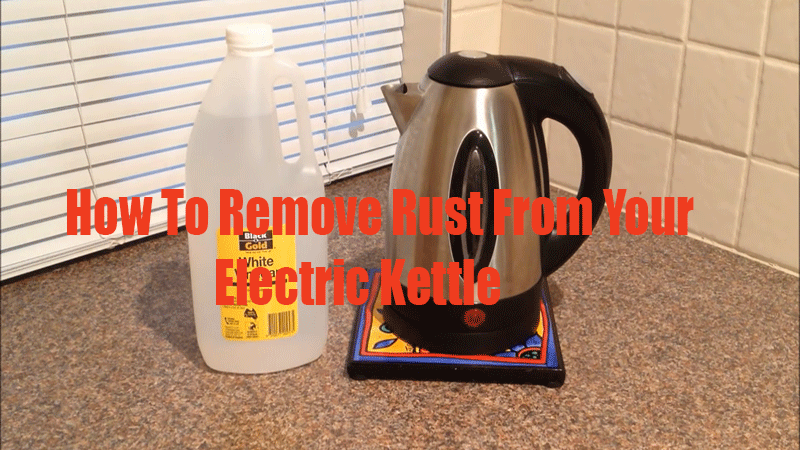
Electric kettles are the quickest and most efficient way to boil water fast. They can be used for all kinds of stuff in the kitchen, including making coffee, tea, and soup.
After a lot of use, the inside of your electric kettle may start to show a crusty, unpleasant-looking buildup. This buildup (called “scale”) can slow down the heating process and cause issues for your water quality as well. The scale on your kettle can look white, yellow, or sometimes reddish like rust.
When you try to scrub scale off of your kettle, you’ll find that it is extremely stubborn. No amount of scrubbing is likely to remove scale buildup entirely.
For this reason, there are tons of commercial products on the market designed to help remove scale. Some of these products do an okay job, but the best product to remove scale from your electric kettle is simple white vinegar or lemon juice.
Table of Contents
How To Get Rid of Corroding From Your Electric Pot Properly
Read on for step-by-step instructions on how to use household products to clean your electric kettle.
Method 1: Vinegar
Vinegar is hands-down the best thing to use for removing scale from your kettle. It’s cheap, 100% effective, and non-toxic.
Follow these easy steps to use vinegar to clean your electric kettle:
Step 1: Add Some Vinegar To Your Kettle
Fill the kettle up to the “maximum fill” line with the vinegar of your choice.
Any vinegar will do, but simple white vinegar is the best. It’s best to avoid apple cider or other more flavorful kinds of vinegar. The aromas and flavors from the vinegar can soak into plastic parts of your kettle and affect the flavor of your tea and coffee.
If you don’t have any vinegar handy, try one of these alternatives:
- Lemon juice: you’ll need a lot of it, so try using the bottled stuff.
- Citric acid: some people have this in their kitchens for making jams and other recipes.
- Commercial products: if you want to get serious, you can try one of the available commercial products designed for cleaning coffee and tea equipment. One of the most popular brands is Dezcal from Urnex, but there are many options to choose from on the market.
Whatever you do, don’t use drinking vinegar or balsamic. These tend to contain lots of sugar and will cause a sticky mess.
Allowing the vinegar to sit and do its job is important. This is a chemical process, and chemical reactions take time.
The longer the vinegar sits in the kettle the better, but 2-3 hours should do the trick. You can scrub or stir if you want to, but it won’t do you any good. Finding your zen and being patient is the key to this step.
Step 3: Boil It
After the vinegar sits for at least 2-3 hours, turn the kettle on and bring it to a boil for about 3-4 minutes. This will cause the liquid to swirl as it boils, which agitates all the little particles scale and helps break them free from the kettle.
Boiling also speeds up some of the final reactions that need to take place and soften the last bits of hard scale.
Step 4: Pour The Vinegar Out And Rinse
Pour out the vinegar. Careful, it’s hot! Once all the vinegar’s out, rinse the kettle with clean cold water.
It’s a good idea to pour out half the vinegar, then give the kettle a vigorous swirl before you pour out the rest. This will make sure than any big chunks of scale wash out with the swirling vinegar.
If there are any streaks or spots of scale left after you finish, repeat this whole process until the kettle is clean and shiny.
What Is Scale?
To understand why vinegar is so good at removing scale, it helps if you understand what scale even is.
First of all, the scale is not rust. Rust is left behind when metals containing iron react with oxygen and begin to break down. The scale is formed when minerals dissolved in the water precipitate (form into a solid). The solidified minerals cling to the metal of your kettle and that’s what you see as scale.
The minerals that are most important to scale buildup are Magnesium Carbonate and Calcium Carbonate. These two are absorbed while water is in the ground, so the amount of each in your tap water depends on your location.
Different areas of the world have different “water hardness” (meaning they have different levels of dissolved minerals).
Can you remove minerals from the water?
Knowing that scale is caused by the minerals in your water, you might think, “Why don’t I just remove the minerals and prevent the scale in the first place?” Well, this is one method that commercial hot water systems use.
If you want to remove minerals from your water, there are a few different ways to do it:
- Are one of the most effective methods of water filtration for home use. These filters use high pressure to force water through a fine membrane, which allows the water molecules through but strips out almost everything else.
- Removes the water from the impurities rather than removing the impurities from the water. Distillation involves heating the water until it evaporates, then capturing the vapor as it condenses onto a surface. The water leaves the heavier stuff behind when it evaporates.
- Pass incoming water through a dense packing of resin that sticks to the minerals and holds them back as the water flows out.
All three of these methods of removing minerals from your water are effective and commonly-used.
The problem is that you want some minerals in your water. Especially if you’re brewing coffee and tea. In fact, there’s a whole section of the specialty coffee industry that does nothing but study the ideal balance of different minerals to get the best flavor from your coffee.
If your water is soft (has no minerals in it), your coffee and tea might taste bitter and over-extracted.
See Other Related Post:

